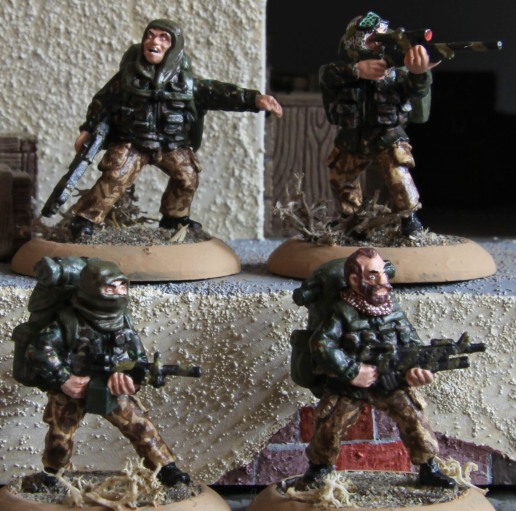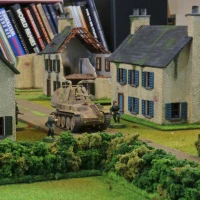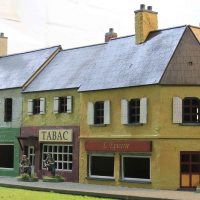
All the posts showing off special forces over the past couple of days have led to some requests for pictures of the remaining NATO force I have miniatures for… the Bundeswehr. While I had planned to postpone this until I had the last vehicles finished (3 Transportpanzer Fuchs and a CH-53 still left to do) I am going to show them anyway. Fist up the vehicles:
This is the mainstay German MBT in current use. The A5 model is the result of the KWS II package (Kampfwertsteigerung II or combat upgrade program II) giving it stronger armour, better electronics and targeting systems. The main gun (120mm smoothbore) and targeting system see use in most other NATO MBTs as well.
The Flakpanzer Gepard is reputed to be the best cannon armed air defense tank world-wide. With its twin 35mm autocannon (ROF 550 rounds per minute) it is able to lay down a massive volume of fire both against air as well as ground targets. In 2000 it was decided that the German army no longer needed close air defense of this type and that these tanks would be phased out and mothballed in favour of the Patriot system until the year 2015. With the new reforms in 2010 the remaining 90 tanks were phased out completely though. Not that this matter since me games are set a couple of years before that!
These two IFV´s represent the latest version of the Schützenpanzer Marder with a turret mounted (dismount-able) Milan launcher on the turret. A Panzergrenadiergruppe (more on that later) will be spread out amongst these two tanks. The models are actually some cheap RC tanks. They required a lot of conversion work to get them here since they represented the A1 version. Which meant moving the roof mounted, rearward firing MG to the turret (co-ax) and the addition of the Milan launcher. Armoured boxes were added to the sides, spaced armour to the front and roof using plasticard.
This is a model of the ABC Spürpanzer (NBC detection tank) Fuchs. Some of these were lend to the US for Desert Storm since this is the most advanced vehicle for NBC detection available. Both the US and the UK have since bought vehicles using it under the English translation Fox. There is also a troop carrier version available and I still have three models in storage where I will have to modify the rear hatches to use them as troop carriers.
Last vehicle is a Unimog, serving as a light truck for my forces. This is a repainted die-cast model.
Up next are the infantry.
These are some Scharfschützen (Snipers) based on the old TO&E. The new organisation calls for two men teams armed with bolt action sniper rifles (G22) or an anti-material rifle (G82). The old organisation had two snipers with G3 rifles. These G3 were the most accurate assault rifles from a batch, remastered and equipped with scopes. They were accompanied by two men to provide them with security. These men were armed with machineguns, usually MG3s. In this case the man on the right has the newer MG4. Minis are from Devil Dog Designs and mostly converted.
This is my Fallschirmjägergruppe (minis from Devil Dog Designs). The Gruppe is the smallest tactical infantry element in the German Army, be it airbourne (like these) or Panzergrenadiere (below), Jäger, Infanterie and so on. A Gruppe consists of 12 men. One of them is a machinegunner, the rest are armed with G36 assault rifles, the Gruppenführer (section leader) usually has and underslung AG36 grenadelaucher. Special weapons like man pack anti-tank or anti-aircraft rocket launchers can be distributed as need be. [These Fallschirmjäger have now been sold and are on their way to a good new home in France.]
All the minis below are Eureka.
Now this first Gruppe is similar in organisation to the Fallschirmjäger above, except that two of the men also have the Milan launchers dismounted from the Marder along. They have often proven useful in games, especially one where the Russian tanks chased after the Marder tanks, missing the dismounted Grenadiere at the forests edge that hit them in the flank with their Milans.
While these two Gruppen also represent Panzergrenadiere they have no Milans but one Panzerfaust 3 each instead. As I said the Marder were a hassle to convert and I was in no mood to do that 4 more times to get a full Zug (platoon). Now in some units only the first Zug is equipped with Marder, the rest rides Fuchs. I just decided to mix this within the Zug, assuming that the commander had distributed the Marder amongst his Züge to given them all an even punch.
Now a few more words on the machinegunner (for all types of Gruppen). A little over a decade ago it was decided that the MG3 would be phased out and replaced with the MG36 (essentially a G36 with heavier barrel and if lucky with a drum magazine). Just like the SA-80 LMG in the British Army this met little approval by the soldiers. They already felt weaker due to the reduced calibre of the G36 when compared to the old G3 and with just one LMG to 12 men (other NATO forces have one LMG per 4 men squad). So commanders found all kinds of excuses to store the MG3s they had and simply handed them out when troops were deployed. So a couple of years ago the MG4 was introduced, which solved the problem since it was at least a proper SAW type of weapon. I have decided to stick to the MG3, since it gives me the most firepower and my games fall into the transitionary period anyway.
Last are the force multipliers.
To the left is a medic with a MP7 PDW (you can also see this on some of the NCO´s and radiomen above). In the middle is a dog handler. Military dogs see more use in the Bundeswehr these days, especially for house clearing. To the right is a GMW 40 automatic grenade launcher. This is about all I need. I just hope Eureka releases a tri-pod mounted MG3 one day… otherwise I will have to do one from a WWII MG42 and convert some crew for it.
The big beauty with the German army is that soldiers wear no unit patches in the field and that the equipment is vastly similar. So I plan to use these men as Panzergrenadiere for the 21. Panzerbrigade, Fällschirmjäger for the Saarlandbrigade or Jäger for the Deutsch-Französische Brigade.



























